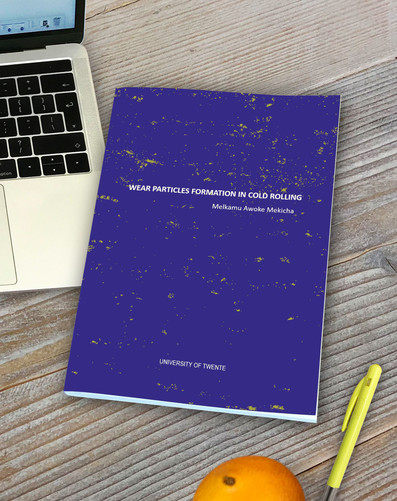
The surface cleanliness of a cold rolled sheet metal is a very important parameter for product performance in many sectors, such as automotive and packaging industries. Wear particles, generated during cold rolling, contaminate the surface and reduce the surface quality of a cold rolled sheet. Furthermore, wear particles can negatively influence downstream processes such as annealing, galvanizing and deep drawing. A detailed understanding of the microscale mechanisms at the roll-strip interface, relevant for wear particles generation, is crucial to enable control and predictability over the surface quality of a cold rolled metal sheet.
The primary aim of this thesis is to develop a physically based multi-scale wear model for the prediction of wear particle generation. This model development is underpinned by fundamental insights into the relevant interfacial mechanisms during cold strip rolling influencing wear particles generation. The final outcome is a multiscale wear model, developed to estimate the severity of wear particles formation in cold rolling processes operating in the boundary lubrication regime. The model is developed through several steps.
A contact model is developed based on existing models in the literature to understand how the real contact area ratio and the nature of the roll-strip contact changes as a function of relevant process parameters, as this affects the interfacial phenomena and thus the wear mechanism of the tribological system. In the contact model, the real contact area ratio is calculated and the micro contacts are identified. The effects of several rolling parameters such as thickness reduction, strip/roll roughness, and rolling speed on the real contact area ratio are investigated in the contact model. The accuracy of the developed contact model was experimentally verified by performing rolling experiments on a two-high pilot mill.
The wear behavior of an individual roll asperity sliding against a flat soft strip was investigated experimentally (using scratch experiments) and numerically. Material point method (MPM) was implemented to numerically model the wear and damage mechanism at single asperity contact in three dimensions. The effect of asperity sharpness, interface shear strength and surface chemistry on wear particles generation were investigated. A study of wear particle removal criterion was carried out, based on critical equivalent plastic strain, in the MPM simulations by using the degree of wear of the scratch experiments as a benchmark. In addition, the effect of hard chrome plating the rolls on wear particles formation was investigated in a single asperity contact to understand the fundamental mechanisms behind the positive effects of chrome plating on strip cleanliness.
Finally, the multi-scale wear model is developed by mapping the macroscale contact model with the single asperity wear model. This is realized by idealizing each micro-contact in the contact model by an elliptical-paraboloid. The wear model was validated by conducting cold rolling experiments with varying process parameters on a pilot scale rolling mill. Moreover, the influence of rolling parameters on wear particles formation was investigated in the rolling experiments. The developed wear model covers the main physical phenomena related to wear particle generation and it can be included in industrial rolling models as both a predictive and retrospective tool.
Download Thesis